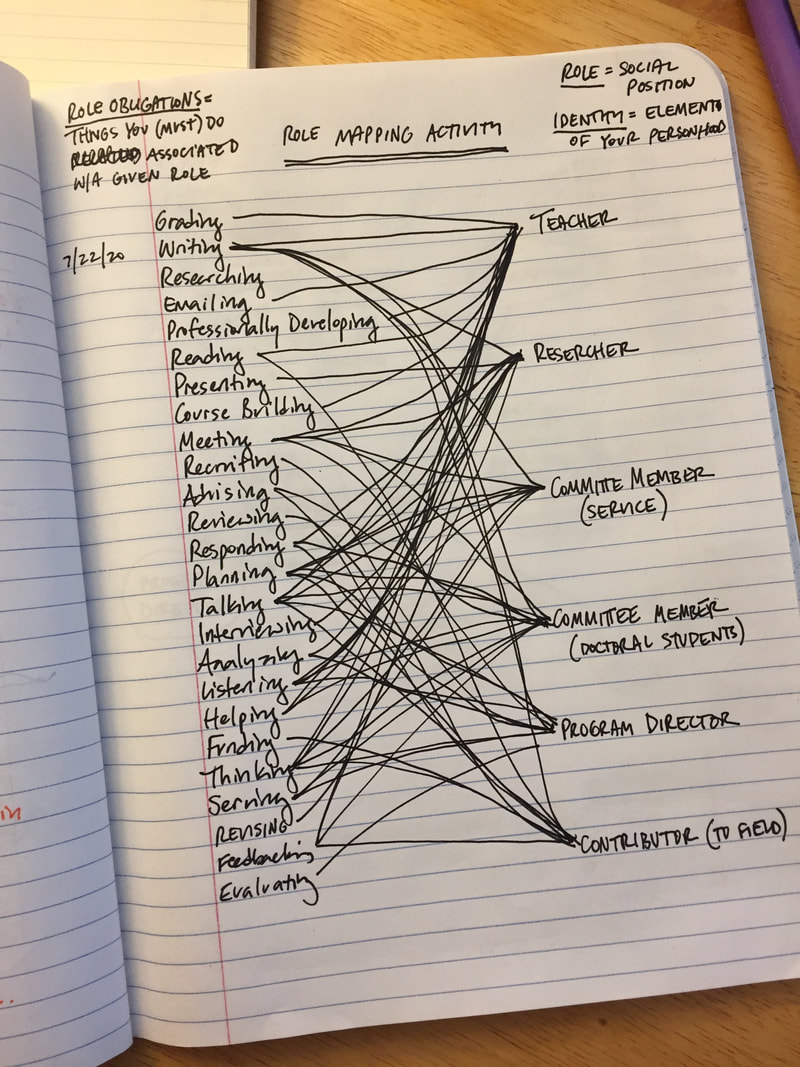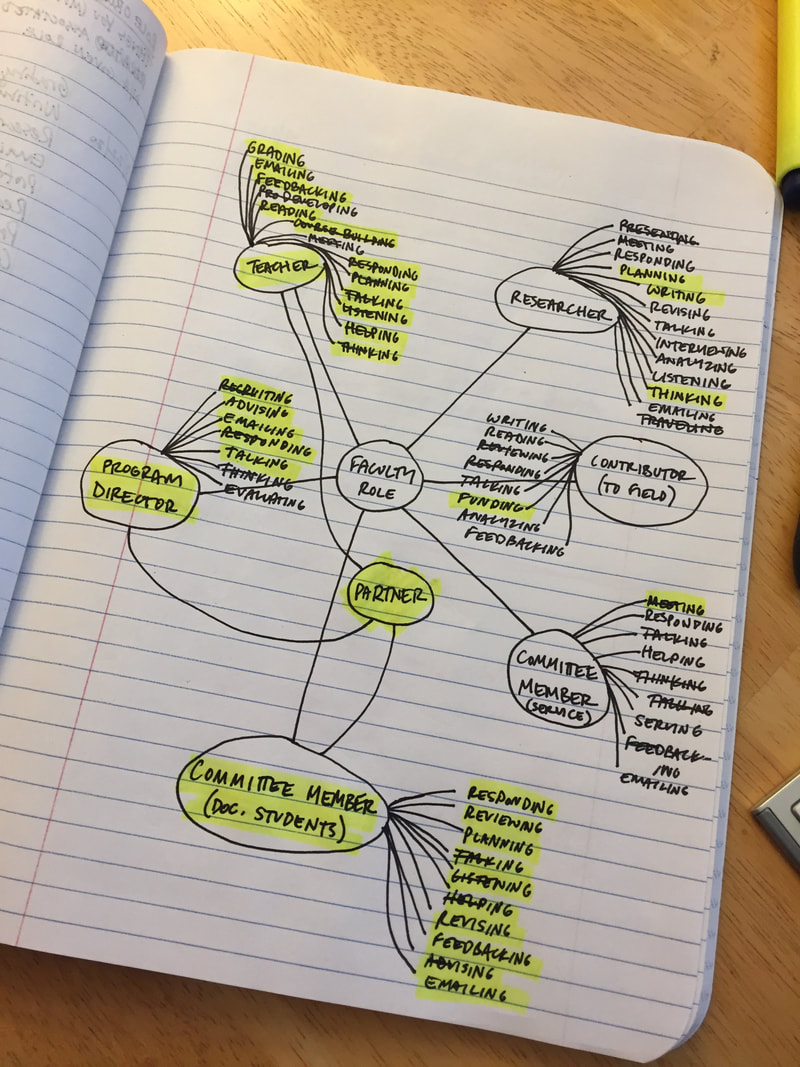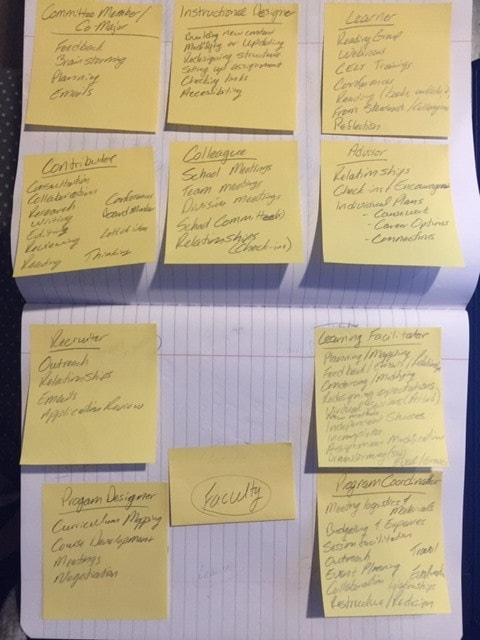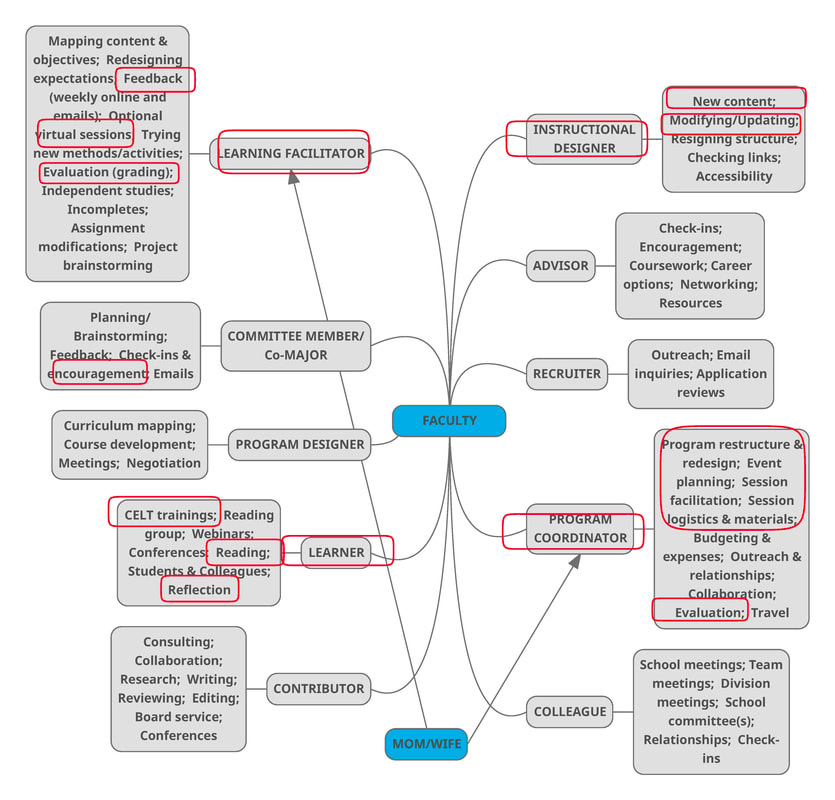Something we will ask our faculty collaborators to do is to create a reflective identity map that illustrates how their roles have shifted in 2020. We also want to include space for faculty to think about how their faculty role interacts with their other identities as people--as parents, children, siblings, cousins, friends, colleagues, and so on. Again, we do not want to ask you to share anything that you can't expect us to share with you, so here are our own identity maps.
Erin's Identity Map and Reflection
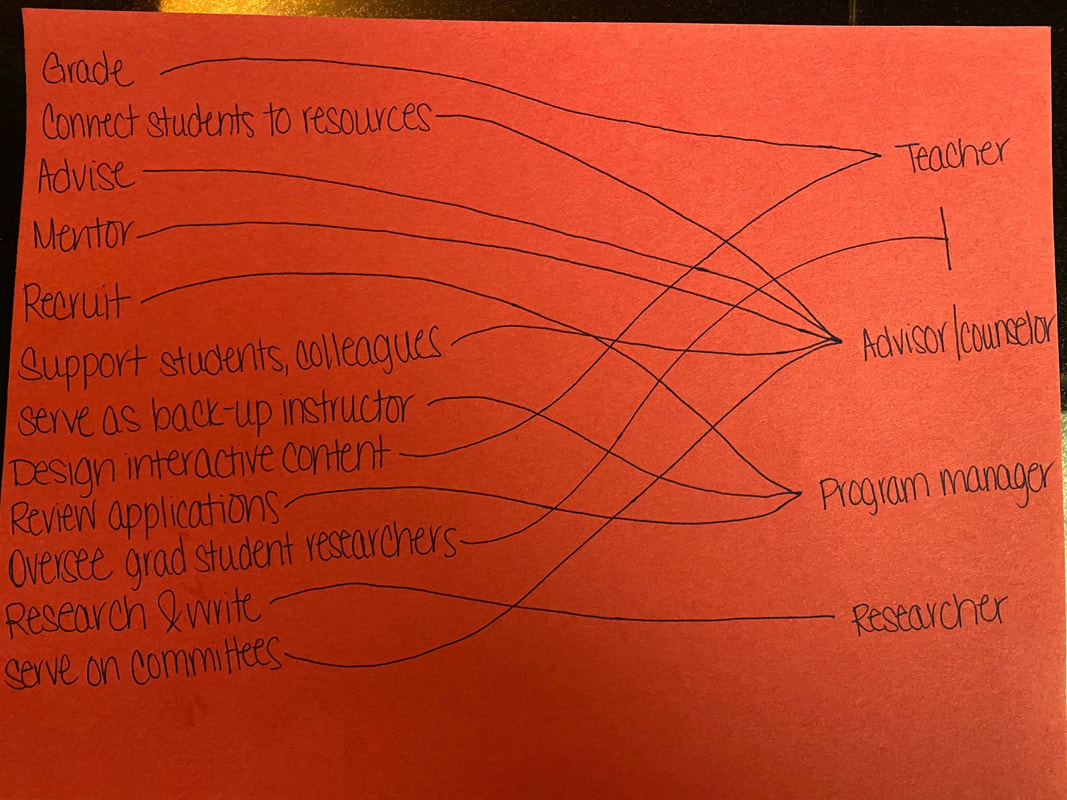
I have to admit that with this first map, I struggled. I think what was difficult for me was in trying to think of all of the things that I may do connected to my work from day to day. I realized a few hours after the fact that I didn't actually capture much that would fall under the "service" bucket--when I said "serve on committees," I was thinking more like dissertation committees, not the administrative committees I'm assigned to. Part of this challenge, in my opinion, is simply due to the fact that nothing about my job has felt totally "normal" since even before COVID hit. I dislocated my kneecap in January (first week of spring classes, actually!), so the entire Spring 2020 semester felt off for me.
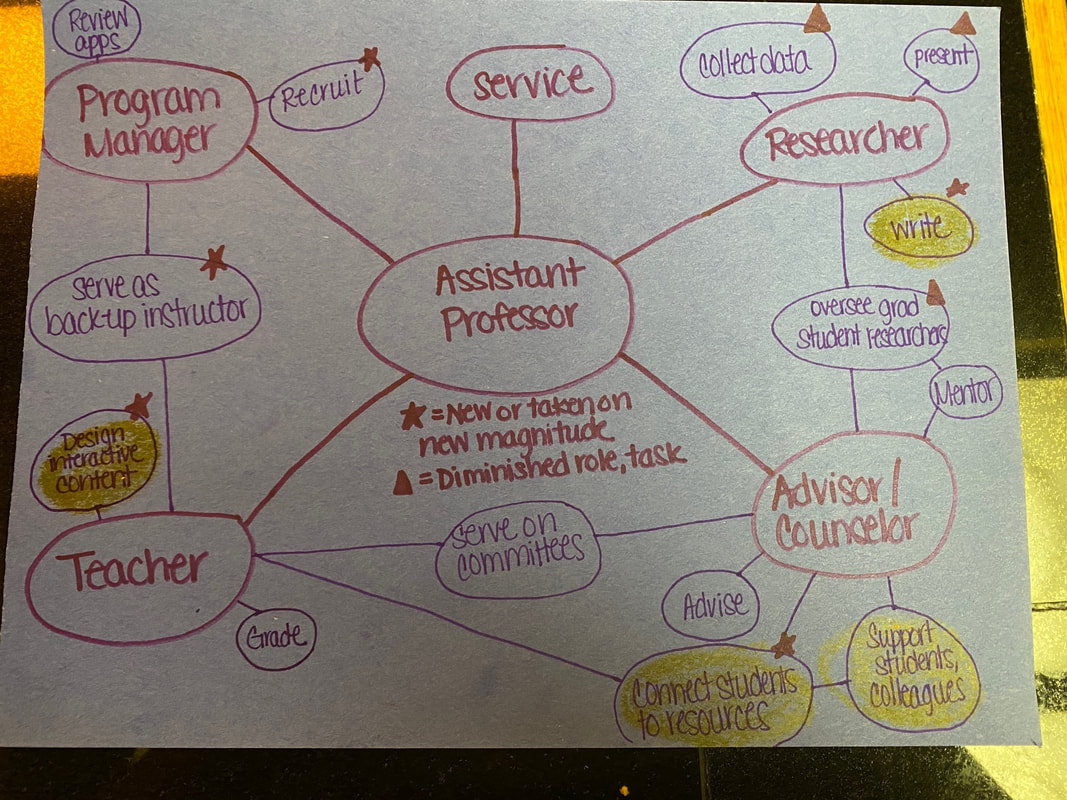
So here, I admittedly (but accidentally!) didn't follow the directions for this exercise that Mandy wrote out. However, I decided to include it rather than revise it for two reasons. First, I knew I could still write out the things that weren't included plus what I was doing with this. Two, I think it's important to note that we aren't going for standardized maps here. If you decide that you want yours to look differently than what the directions entail, that's fine. This is something we can totally discuss in the individual interviews.
So some things here: First, it's interesting to think about what roles/tasks have become almost obsolete because of COVID in particular. Since face-to-face research is highly restricted, I can't collect data unless I'm online and that makes tagging in graduate researchers a bit more challenging. With so many conferences cancelled, my main way for disseminating my research is through writing manuscripts. While this has always been a key part of my role, it's taken on new magnitude.
The coronavirus pandemic has prompted major anxieties about enrollment in institutions of higher education at virtually all levels. My colleagues and I realized even pre-COVID that we needed to do a better job of outreach and recruitment, but since then, I've felt like recruitment has become a major task of my work.
Related to the pandemic are two teaching-related tasks: 1. Having to be a back-up instructor to a course in case a colleague of mine gets COVID and cannot teach to their full capacity.
2. I feel even more pressure to design better and more interactive content. In the fall 2020 semester, I'm teaching my Equity, Diversity, and Inclusion in Student Affairs class, and after feeling the impacts of the last few months, especially after the murders of Breonna Taylor, Ahmaud Arbury, and George Floyd, I feel a big responsibility to really get this class right.
The yellow-ish circles are the tasks/roles that I feel like are most prominent in my day-to-day life (bear in mind, it's still officially summer as I write this).
1. Connecting students to resources was one of the first pressures I felt when COVID set in. I felt like I needed to educate myself about things like the CARES Act, to be aware of what monies the university was distributing to students, and making sure that all of my students knew what resources were available to them.
2. For supporting students and colleagues, this work can be time-consuming, distracting, and hard--especially if I feel like I'm not getting supported as well. It's hard to advise and mentor students when so much is in the air. I can't know how my colleagues, especially those who are pre-tenure and who have children, feel about their options to either try to homeschool their kids or send them back to school in-person. I'm on a LOT of group text messages, needless to say.
So what don't my maps capture?
They don't tell the whole story of me: I'm a daughter of two parents who I adore, who live 1,000 miles away, and who are in high-risk categories for COVID. This doesn't capture the anxiety I feel of worrying that my parents or my in-laws will contract this awful virus that is so devastating for people in their age range.
I'm a partner to a talented and capable husband--but in quarantine, we can drive each other absolutely crazy in all the worst ways. We do our best to support each other and to deal with our respective anxieties in healthy, constructive ways, but it's difficult some days.
I'm a sister and aunt to 2 girls who are my absolutely favorite people in the world. I was willing to break a strict quarantine in order to hug them tightly so I wouldn't worry they'd somehow forget about me.
I'm a multi-ethnic woman who was more commonly considered white when I lived in Texas but am now more Latina now that I live in Iowa. I have white privilege, but I don't know that I consider myself white. But I am trying hard to reflect on what that means and what my responsibility is in furthering racial justice in the United States, especially in the predominantly White context where I currently live.
There's a lot more I could add that intersects with these various roles of being a faculty member, but I'll leave it here for now.
So some things here: First, it's interesting to think about what roles/tasks have become almost obsolete because of COVID in particular. Since face-to-face research is highly restricted, I can't collect data unless I'm online and that makes tagging in graduate researchers a bit more challenging. With so many conferences cancelled, my main way for disseminating my research is through writing manuscripts. While this has always been a key part of my role, it's taken on new magnitude.
The coronavirus pandemic has prompted major anxieties about enrollment in institutions of higher education at virtually all levels. My colleagues and I realized even pre-COVID that we needed to do a better job of outreach and recruitment, but since then, I've felt like recruitment has become a major task of my work.
Related to the pandemic are two teaching-related tasks: 1. Having to be a back-up instructor to a course in case a colleague of mine gets COVID and cannot teach to their full capacity.
2. I feel even more pressure to design better and more interactive content. In the fall 2020 semester, I'm teaching my Equity, Diversity, and Inclusion in Student Affairs class, and after feeling the impacts of the last few months, especially after the murders of Breonna Taylor, Ahmaud Arbury, and George Floyd, I feel a big responsibility to really get this class right.
The yellow-ish circles are the tasks/roles that I feel like are most prominent in my day-to-day life (bear in mind, it's still officially summer as I write this).
1. Connecting students to resources was one of the first pressures I felt when COVID set in. I felt like I needed to educate myself about things like the CARES Act, to be aware of what monies the university was distributing to students, and making sure that all of my students knew what resources were available to them.
2. For supporting students and colleagues, this work can be time-consuming, distracting, and hard--especially if I feel like I'm not getting supported as well. It's hard to advise and mentor students when so much is in the air. I can't know how my colleagues, especially those who are pre-tenure and who have children, feel about their options to either try to homeschool their kids or send them back to school in-person. I'm on a LOT of group text messages, needless to say.
So what don't my maps capture?
They don't tell the whole story of me: I'm a daughter of two parents who I adore, who live 1,000 miles away, and who are in high-risk categories for COVID. This doesn't capture the anxiety I feel of worrying that my parents or my in-laws will contract this awful virus that is so devastating for people in their age range.
I'm a partner to a talented and capable husband--but in quarantine, we can drive each other absolutely crazy in all the worst ways. We do our best to support each other and to deal with our respective anxieties in healthy, constructive ways, but it's difficult some days.
I'm a sister and aunt to 2 girls who are my absolutely favorite people in the world. I was willing to break a strict quarantine in order to hug them tightly so I wouldn't worry they'd somehow forget about me.
I'm a multi-ethnic woman who was more commonly considered white when I lived in Texas but am now more Latina now that I live in Iowa. I have white privilege, but I don't know that I consider myself white. But I am trying hard to reflect on what that means and what my responsibility is in furthering racial justice in the United States, especially in the predominantly White context where I currently live.
There's a lot more I could add that intersects with these various roles of being a faculty member, but I'll leave it here for now.
Mandy's Identity Map and Reflection
MANDY’S ROLE MAPPING REFLECTION (7/22/20)
WHOA! This activity, which I wrote the directions for before actually doing, was a lot. While I subsequently altered the directions to account for what seemed a bit wonky, this was still a more complex and complicated process than I anticipated. In many ways, its messiness is so emblematic of my life right now. When my partner looked at the first page, she looked at me and said “That makes my head hurt.” I was, in fact, battling against a headache yesterday.
Well, I do a lot, it seems. And the process was iterative. Progress within the process often caused me to go back and fill in gaps as they became apparent. Even as I reflect and look back upon the map now, I am “seeing” things I neglected to add, like posting on social media, which I could consider an obligation of several sub-roles. It was cleansing (?) to draw this all out, and I honestly wish someone would interview me about it as a cathartic experience.
My faculty role consists of the following sub-roles: teacher, researcher, program director, committee member (service), committee member (doctoral students), and contributor (to the field), which feels different to me than researcher. I am now spending most of my time on the teacher, program director, and committee member (doctoral students) sub-roles. All of these roles and obligations were present in 2019, but many were not as pronounced as they are right now. Examples of role obligations that seem to have grown in terms of time spent include (partial line throughs and highlights): professionally developing, course building, meeting, planning, responding, talking, listening, helping, thinking, recruiting, advising, and meeting. It is summer. I am not on contract right now, but I have never had a busier or more high-paced or hectic summer. This activity makes me think about the current invisibility of my work, how exhausted I am, whether or not I can do more with less, and how sustainable all this is. The process has been sobering, eye-opening, and demanding of ongoing reflection and eventual action.
I look forward to talking to community college faculty to have done this exercise as we co-construct what this year is and has been like for us. Like we have mentioned elsewhere, Erin and I are really looking forward to this project and being in community with others along the way.
WHOA! This activity, which I wrote the directions for before actually doing, was a lot. While I subsequently altered the directions to account for what seemed a bit wonky, this was still a more complex and complicated process than I anticipated. In many ways, its messiness is so emblematic of my life right now. When my partner looked at the first page, she looked at me and said “That makes my head hurt.” I was, in fact, battling against a headache yesterday.
Well, I do a lot, it seems. And the process was iterative. Progress within the process often caused me to go back and fill in gaps as they became apparent. Even as I reflect and look back upon the map now, I am “seeing” things I neglected to add, like posting on social media, which I could consider an obligation of several sub-roles. It was cleansing (?) to draw this all out, and I honestly wish someone would interview me about it as a cathartic experience.
My faculty role consists of the following sub-roles: teacher, researcher, program director, committee member (service), committee member (doctoral students), and contributor (to the field), which feels different to me than researcher. I am now spending most of my time on the teacher, program director, and committee member (doctoral students) sub-roles. All of these roles and obligations were present in 2019, but many were not as pronounced as they are right now. Examples of role obligations that seem to have grown in terms of time spent include (partial line throughs and highlights): professionally developing, course building, meeting, planning, responding, talking, listening, helping, thinking, recruiting, advising, and meeting. It is summer. I am not on contract right now, but I have never had a busier or more high-paced or hectic summer. This activity makes me think about the current invisibility of my work, how exhausted I am, whether or not I can do more with less, and how sustainable all this is. The process has been sobering, eye-opening, and demanding of ongoing reflection and eventual action.
I look forward to talking to community college faculty to have done this exercise as we co-construct what this year is and has been like for us. Like we have mentioned elsewhere, Erin and I are really looking forward to this project and being in community with others along the way.
Zoë's Identity Maps and Reflection
I started this activity using sticky notes and then used a free online mind mapping tool…only because I couldn’t fit everything on a single handwritten page. Is it possible to have too many sub-roles? Maybe mine looks the way it does because I try to compartmentalize for my own self-care. While I certainly don’t wear all of these hats at once, I do juggle most of them for an amount of time in any given week: Learning Facilitator (I relate to this term rather than teacher when describing myself); Instructional Designer; Program Coordinator (noncredit extension); Program Designer (credit); Advisor; Committee Member/Co-Major; Contributor; Recruiter; Colleague; Learner.
This activity validated a few things for my faculty role(s). While my own class environment has not shifted with the health pandemic (I’ve been facilitating online courses every semester since I arrived at ISU), the nature of our program is such that most of our students have professional roles in which they themselves are supporting and teaching and caring for students. So at the forefront of my 2020 efforts has been responsiveness and flexibility to allow them space to care for their own communities, students, and families. This has resulted in more time spent redesigning expectations for projects and student interactions, as well as working independently with several students on assignment and timeline modifications.
Our leadership development programs have been delayed and moved online, due to the significant uncertainty we faced during the summer. This has relieved me of some tasks and responsibilities for now, allowing me time needed for heightened attention to my classes. However, this will change in October when everything is in motion, not to mention the added dynamic of restructuring this program for online delivery with a shortened schedule.
My professional role has always impacted my family role through evening class commitments, travel, and late night or Saturday morning evaluation/grading – this being part of the reason I’ve tried to maintain boundaries as best I can. However, the health pandemic has required me to create new spaces and time to carry out my responsibilities, and threatens those boundaries I hold dear. I’ve also struggled with trying to create meaningful and special memories with my family, as it seems now that we are always just hanging out – I’ve heard many more complaints of “I’m bored” these past 6 months than usual.
One significant collision of my faculty and personal roles occurred with the derecho that ravaged much of Iowa in August, the day before final grades were due for my summer class. After surviving the incredible storm and surveying the damage, I spent multiple frantic hours driving around the nearest town to find internet and cell service strong enough to access the final papers, provide substantial feedback, and submit final grades. My search was made more difficult with the health pandemic limiting access to public spaces that did have power and internet. This meant that my family was attending to the most crucial clean-up during the first two days, while I was struggling with the dual frustrations of not helping my family in crisis and not having the time or technology to more than adequately serve my students.
Most significantly, 2020 has forced me to question even more the experiences I create (or more to the point, fail to create) to foster awareness and understanding, and specifically to craft actions for racial equality and social change. Although I identify as a lifelong learner, I’ve spent much more time in my Learner role during 2020, specifically focusing on anti-racism, White privilege, and advanced distance learning methods.
This activity validated a few things for my faculty role(s). While my own class environment has not shifted with the health pandemic (I’ve been facilitating online courses every semester since I arrived at ISU), the nature of our program is such that most of our students have professional roles in which they themselves are supporting and teaching and caring for students. So at the forefront of my 2020 efforts has been responsiveness and flexibility to allow them space to care for their own communities, students, and families. This has resulted in more time spent redesigning expectations for projects and student interactions, as well as working independently with several students on assignment and timeline modifications.
Our leadership development programs have been delayed and moved online, due to the significant uncertainty we faced during the summer. This has relieved me of some tasks and responsibilities for now, allowing me time needed for heightened attention to my classes. However, this will change in October when everything is in motion, not to mention the added dynamic of restructuring this program for online delivery with a shortened schedule.
My professional role has always impacted my family role through evening class commitments, travel, and late night or Saturday morning evaluation/grading – this being part of the reason I’ve tried to maintain boundaries as best I can. However, the health pandemic has required me to create new spaces and time to carry out my responsibilities, and threatens those boundaries I hold dear. I’ve also struggled with trying to create meaningful and special memories with my family, as it seems now that we are always just hanging out – I’ve heard many more complaints of “I’m bored” these past 6 months than usual.
One significant collision of my faculty and personal roles occurred with the derecho that ravaged much of Iowa in August, the day before final grades were due for my summer class. After surviving the incredible storm and surveying the damage, I spent multiple frantic hours driving around the nearest town to find internet and cell service strong enough to access the final papers, provide substantial feedback, and submit final grades. My search was made more difficult with the health pandemic limiting access to public spaces that did have power and internet. This meant that my family was attending to the most crucial clean-up during the first two days, while I was struggling with the dual frustrations of not helping my family in crisis and not having the time or technology to more than adequately serve my students.
Most significantly, 2020 has forced me to question even more the experiences I create (or more to the point, fail to create) to foster awareness and understanding, and specifically to craft actions for racial equality and social change. Although I identify as a lifelong learner, I’ve spent much more time in my Learner role during 2020, specifically focusing on anti-racism, White privilege, and advanced distance learning methods.
How to enroll in this study
If you are interested in collaborating with us on this study, the first step is in visiting this link: https://iastate.qualtrics.com/jfe/form/SV_4SJosCl5IfJB1Yx or CLICK HERE.
This link provides more information on the study and the consent form. If you choose to consent to be a part of this study, you'll be directed to a second page to provide us with contact information as well as demographic information.
We are deliberately keeping the number of collaborators in this study smaller (about 25 total). If you are chosen for the study, one of us will email you to set up a time and day for the Zoom interview and to send you directions on how to complete a reflective map ahead of the interview.
This link provides more information on the study and the consent form. If you choose to consent to be a part of this study, you'll be directed to a second page to provide us with contact information as well as demographic information.
We are deliberately keeping the number of collaborators in this study smaller (about 25 total). If you are chosen for the study, one of us will email you to set up a time and day for the Zoom interview and to send you directions on how to complete a reflective map ahead of the interview.
